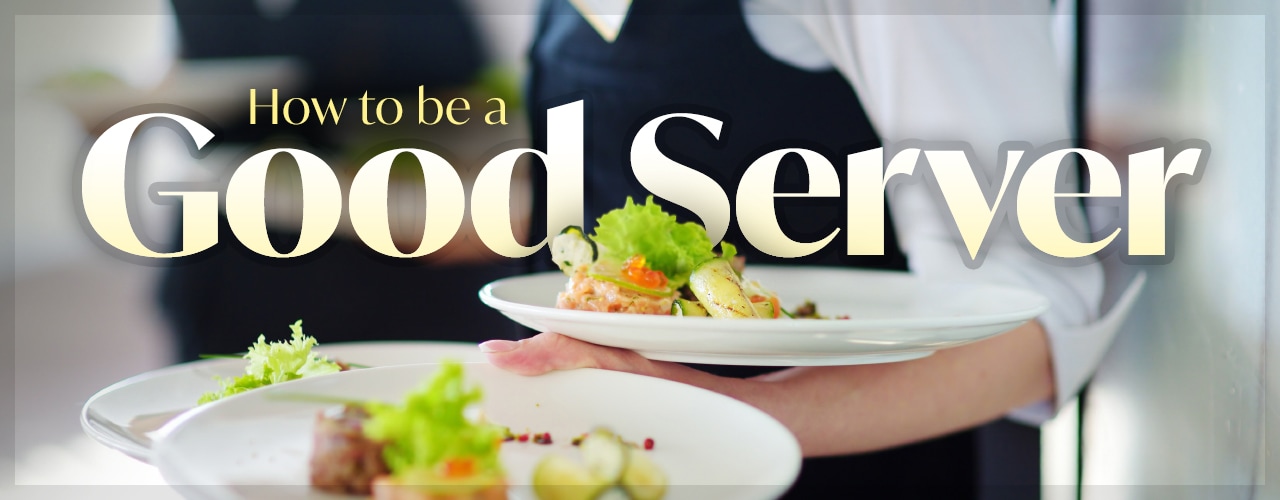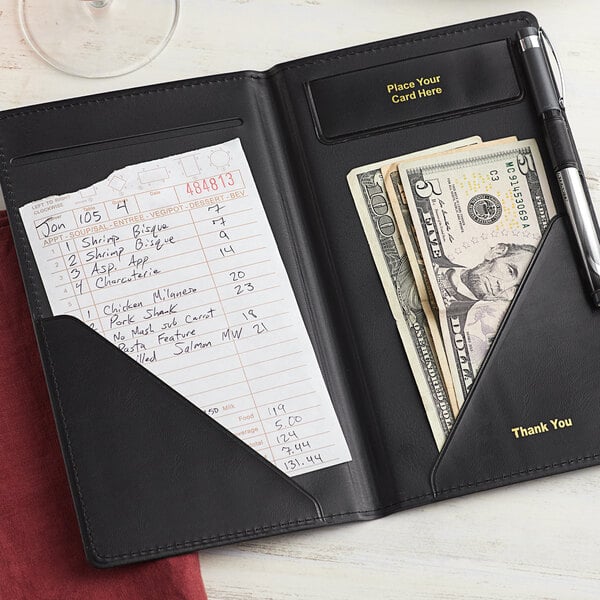
As a server in the foodservice industry, your role is crucial in providing excellent customer service and ensuring a positive dining experience for patrons. Being a good server goes beyond just taking orders and delivering food – it requires a combination of skills, knowledge, and professionalism. By mastering the art of serving, you can enhance customer satisfaction, increase tips, and build a strong reputation for yourself and the establishment you work for.
How to Be a Better Server
In addition to your server training plan, you can take agency over your performance by developing professionally. Untap your serving potential by exploring our server tips below.
1. Create a System of Organization that Works for You

In such a fast-paced environment, it’s easy to lose track of tables or forget an important step. For this reason, it’s essential to come up with a way to organize everything you need to do, giving you a sense of control and diligence over your shift. If you prefer not to use a notepad because it takes you out of the flow, that works. On the other hand, if you prefer to write things down, consider creating simple lists or charts. Here is an example:
- If you know that most tables order three courses, write down “1, 2, 3” once the table has ordered. Cross out each number once the guests have gotten each course and you have already gone back to check on them after each course has been served. In this way, you can keep track of the stage of the meal and ensure that you are being attentive.
Experiment with what works for you, and don’t be afraid to take a minute or two to go through your notepad and make sure you are keeping up.
2. Double and Triple Check Orders
It is better to go back and ask a guest if they ordered pork or steak instead of using up the kitchen’s inventory and having your guest wait another 30 minutes for a new dish. Below are 2 tips to minimize order mistakes:
- If you think you may have written something down wrong, or if you forgot what a guest said, it is perfectly okay to go back to a table and kindly let the guest know you are just making sure you have their order right. Most guests will not mind and will appreciate your personalized attention to detail.
- Once you have typed everything into your POS system, it’s a good idea to double check that you’ve put in everything correctly and included all orders. Taking the extra minute to double check can minimize food waste, increase overall efficiency, and ensure your guests are satisfied.
3. Be Prepared to Discuss the Menu
Not only is it critical to know exactly what is in each dish for allergen reasons, but it is helpful for guests if you are able to describe each dish: what it tastes like, the size of the dish, what it looks like, or what is unique about it. Some guests may also ask for recommendations, so it is wise to pick a few dishes beforehand and be able to explain them well. It is also necessary to know how your menu works; be able to give advice on how much or how little food a table should order, which plates are good for sharing, and how a guest should structure their meal. For example, you can recommend that guests choose multiple courses or you can suggest drink and beverage pairings, which can also create a larger check.
4. Upsell without Pressuring
Throughout the meal, you can try and upsell to create a heftier check. Upselling simply means that you attempt to have your customer choose more expensive items or more items overall. You can do this by describing dishes or drinks in a particularly enticing way. Additionally, using assumptive, suggestive language like “What would everyone like to drink this evening?” can encourage guests to choose a drink even if they weren’t going to in the first place. Below are other tips for upselling:
- Recommend Appetizers - Instead of asking if guests would like an appetizer, say something like: “Can I bring you some nachos?”
- Offer Extras and Toppings - If a guest orders a baked potato and toppings are an extra cost, feel free to ask if they would like cheese, sour cream, and bacon on top.
- Suggest High-Tier Liquor - Anytime a guest orders a basic cocktail like a gin and tonic or rum and cola, most liquor-serving establishments will give them the lowest cost spirit available. However, if guests call out a specific higher tier of liquor (a call drink), it costs more. You can encourage call drinks by saying something like, “Would you like Bacardi rum with your cola?”
- Encourage Guests to Order Desserts - Instead of asking if guests would like dessert, consider saying something like, “This evening for dessert, we are featuring a flourless chocolate cake with a strawberry glaze. Can I interest you?
5. Maintain Composure

While you do need to move quickly as a server, it is better to be composed and diligent even if that means you are operating at less than lightning speed. It’s important to stay present so that you are truly taking in what your guests, coworkers, or managers might be relaying to you, minimizing forgetfulness. Below are some ways to ensure that you can stay calm, organized, and composed during service:
- It can be beneficial to take a moment and look over your notepad and assigned tables.
- Study the menu beforehand and ask any necessary questions about the dishes or any procedures you are uncertain about to your coworkers, the chefs, or your manager.
- Practice your opening introduction.
- Take deep breaths throughout service and before reacting to situations, such as unhappy guests or feedback from your manager. You will be able to avoid reacting unprofessionally and defensively by taking a breath and thinking about how to address the situation.
6. Respond to Mistakes Gracefully
Mistakes are likely to happen in such a bustling atmosphere. As such, it’s important to handle them well. If you put in the wrong order for a guest or forgot to bring them another drink, be sure to emphasize that you recognize their dissatisfaction and are willing to go above and beyond to fix it. This shows that you care about your guests, and it will likely neutralize any impact it may have had on your tip. If you handle it particularly well, guests may actually tip you higher.
7. Be Attentive and Tactful When Checking on Guests
As soon as dishes have arrived and guests have taken their first bite, check back on the table to see how everything is, if anything was forgotten, and if they need anything. Try not to come over to tables right when they are chewing, and don’t visit too often in order to give your guests space to enjoy their own experience.
8. Always Say “I’ll Find Out” over “I Don’t Know"
Part of being a good server is making your guests feel that they are taken care of and in good hands. Saying “I don’t know” has a finality to it and lessens your authority. On the other hand, “I’ll find out” keeps the conversation flowing and shows your guests that you have things under control, even if you don’t know the answer immediately.
9. Be Personable and Authentic

But be able to read a table. If it doesn’t seem like guests want to engage in conversation, be sure to leave them be while still being friendly. If guests do want to interact, it can be worthwhile to engage because creating relationships with customers can increase loyalty and tips.
It can be easy to move into autopilot when serving because you may adopt your server hospitable persona. However, guests will appreciate your authenticity, especially if you are having a conversation with them. Below are some ways you can embody a personable aura with guests and customers:
- Introducing yourself
- Smiling at customers
- Writing “thank you” or drawing a happy face on checks
10. Don’t Be Afraid to Ask Questions
In such a dynamic, quick work environment, it is natural that you might not know how to do everything or you may not have a perfect way to describe every dish. If you aren’t sure about something, take action by asking a coworker or your manager to walk things through with you or to give you advice. This shows that you care about your work, and it helps you feel confident while on the floor.
11. Integrate New Technology and Trends
In today's fast-paced restaurant industry, staying up-to-date with the latest technology and trends is crucial for servers looking to enhance their efficiency and provide exceptional service. By embracing new tools and methods, servers can streamline operations, improve customer experience, and boost overall productivity.
- Point of Sale (POS) systems - These systems not only streamline the ordering process but also provide valuable insights into sales trends and customer preferences. By familiarizing yourself with the POS system in your establishment, you can expedite transactions, track orders accurately, and ensure a seamless dining experience for your guests.
- Mobile Ordering Systems - Mobile ordering systems allow customers to browse menus, place orders, and make payments directly from their smartphones or tablets. By familiarizing themselves with mobile ordering platforms and guiding customers through the process, servers can enhance the dining experience and increase customer satisfaction.
- Contactless Payment - Contactless payment methods, such as mobile wallets and tap-to-pay systems, have become increasingly popular in recent years. Servers can streamline the checkout process by encouraging customers to use contactless payment methods, reducing wait times and minimizing the handling of cash or credit cards.
12. Handle Campers
Handling customers who linger at their table long after finishing their meal requires patience and tact. While it's important to provide excellent service to all customers, managing dining campers effectively is crucial to ensure a smooth dining experience for other patrons and maintain a steady flow of guests in your establishment. Politely checking in on them periodically, offering dessert or coffee, and presenting the check in a timely manner can gently nudge them toward concluding their dining experience.
If dining campers show no signs of leaving, it's important to maintain a friendly and professional demeanor while subtly indicating that their table will soon be needed for other guests. Communicate the restaurant's policy on table turnover politely and offer assistance with any additional needs they may have.
Back to TopHow to Get More Tips as a Server

As a server, one of the key factors that can significantly impact your earnings is the amount of tips you receive from customers. Tipping is common in nearly all restaurants and often makes up the bulk of a server's earnings. Tips are a direct reflection of the quality of service you provide, and there are several strategies you can implement to increase the amount of tips you receive.
- Provide Exceptional Customer Service - The foundation of getting more tips as a server is to consistently deliver exceptional customer service. Greet customers with a warm and friendly attitude, be attentive to their needs, and ensure that their dining experience is enjoyable from start to finish.
- Personalize the Dining Experience - Building a rapport with your customers can make a significant difference in the tips you receive. Remembering regular customers' preferences, engaging in friendly conversation, and providing personalized recommendations can create a more memorable dining experience that encourages customers to tip generously.
- Anticipate Needs and Be Proactive - Anticipating customers' needs and being proactive in addressing them can leave a positive impression and increase the likelihood of receiving higher tips. Keep an eye on table dynamics, refill drinks promptly, and offer additional condiments or utensils before customers have to ask.
- Maintain a Positive Attitude - A positive attitude can go a long way in enhancing the customer's overall dining experience. Even during busy or stressful times, maintaining a friendly and upbeat demeanor can create a more pleasant atmosphere for customers, leading to increased tips.
- Handle Complaints Professionally - In the event of a customer complaint, it's important to handle the situation professionally and promptly. Apologize sincerely, address the issue promptly, and offer a solution to ensure that the customer leaves satisfied.
How to Be a Good Server When Busy
When working as a server, it is essential to maintain a high level of service even during busy times. When the restaurant is packed with patrons, here are some things you can do as a server to ensure your service remains top-notch:
- Prioritize Tasks - During peak hours, it is crucial to prioritize tasks based on urgency. Focus on serving customers promptly, refilling drinks, taking orders efficiently, and delivering food promptly above all other tasks.
- Stay Calm Under Pressure - Busy times in a restaurant can be stressful, but it is important to remain calm and composed. Take a deep breath, stay focused, and tackle each task one at a time.
- Communicate Effectively - Clear communication is key when the restaurant is busy. Make sure to communicate effectively with your team members, kitchen staff, and customers. Clearly relay orders, special requests, and any delays to ensure smooth service flow.
- Be Flexible - Be willing to adapt to changing circumstances, handle unexpected situations with grace, and accommodate customer requests to the best of your ability. Being flexible can help you navigate busy times smoothly and provide top-notch service to guests.
How to Greet a Table as a Server

As a server in the foodservice industry, greeting a table is a critical step in providing excellent customer service. The way you approach and interact with your guests sets the tone for their entire dining experience. Here are some key points to keep in mind when greeting a table as a server:
- Approach with Confidence - When approaching a table, it's essential to exude confidence and professionalism. Make eye contact, smile warmly, and greet the guests with a friendly and welcoming demeanor.
- Introduce Yourself - After greeting the table, introduce yourself by stating your name. Doing so adds a level of friendliness and allows them to address you by name if they need any assistance during their meal.
- Be Attentive and Ask Questions - As you greet the table, take note of any special requests, dietary restrictions, or preferences that the guests may have. Pay attention to cues such as body language, tone of voice, and facial expressions to gauge their mood and level of engagement.
- Offer Assistance and Recommendations - After introducing yourself, inquire if the guests have any questions about the menu or if they need recommendations. Be prepared to provide information about the dishes, ingredients, and preparation methods to help them make informed choices.
In the fast-paced and dynamic environment of the foodservice industry, being a good server is essential for providing excellent customer service and ensuring a positive dining experience. Remember, being a good server is not just about taking orders and delivering food – it's about creating memorable experiences, anticipating needs, and exceeding expectations. Implement these best practices in your daily interactions with guests to elevate your service and leave a lasting impression.





